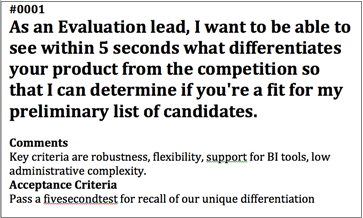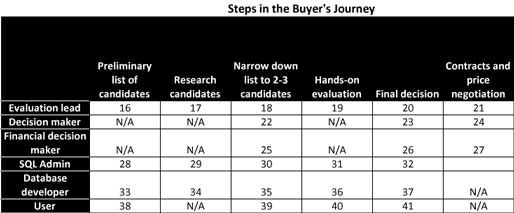 I’ve written previously about how to write user stories here. But as I’ve gained more experience implementing Agile Marketing, I’ve realized that it’s not enough to understand how to write Agile Marketing user stories. We also need a process for identifying as complete a set of useful user stories as possible. I’d like to suggest the following four step process:
I’ve written previously about how to write user stories here. But as I’ve gained more experience implementing Agile Marketing, I’ve realized that it’s not enough to understand how to write Agile Marketing user stories. We also need a process for identifying as complete a set of useful user stories as possible. I’d like to suggest the following four step process:
- Identify your personas
- For each persona, identify the “jobs to be done”
- For each persona, identify the steps in the buyer’s journey
- Develop a matrix from the steps above
Bear with me. There’s a lot here, but if you follow the process, you’ll find that you can document 99% or more of your user stories, which will make your selling and content creation much easier and win you major brownie points with your sales staff.
Personas

I’m a big fan of using Personas in marketing. I use a template provided to me by my friend Todd Warren, which in turn is based on some of the work of Karen Holtzblatt. If you’d like a copy of the template, you can download it here. My template includes basic demographics, attributes, a scenario that describes why the user would be interested in your product or service, his goals and aspirations and his information sources. Each of these should be documented by talking to real customers, not by your best guesses based on “experience”.
Companies also benefit from getting a common understanding of their personas. Each piece of content marketing should be addressed to a persona, each blog post, each tweet, each Facebook post. It should go without saying that products should be designed for individual personas.
Jobs To Be Done
I love this concept. I first learned about it from Hutch Carpenter, who is one of the best bloggers around about product management. Jobs to be done is one of those concepts that seems obvious at first, but the more you work with it, the more you realize that it’s brilliant. Understanding your customer’s jobs to be done helps you orient yourself to your customer’s point of view, and also provides a way to avoid The Innovator’s Dilemma if you constantly update them. Your initial product may have satisfied one or two specific jobs to be done, but as your customer’s jobs to be done change over time, you need to respond to them, and modify your existing product or create new products to address these new jobs.
Hutch provides some great examples of jobs to be done for television viewing. I’d like to suggest a few jobs to be done for my smartphone:
| Situation | Job to be Done | Success Metric |
| I just unlocked my phone | Show me the latest communications of any type (email, text, voice mail, Facebook, Twitter) from my spouse, all in one place | Decreased steps to do all this |
| Getting into my car | Give me a choice of listening to music, resuming the Audible book I was listening to, making a phone call, having my latest emails read to me, or peace and quiet | Increased user satisfaction |
| Listening to music on my phone | Recommending new playlists based on my existing playlists | Increased listening |
Once you’ve documented the jobs to be done, you should find that they fall into one of three buckets:
- Jobs to be done that our product or service does well today
- Jobs to be done that our product or service does, but not well
- Jobs to be done that our product or service doesn’t do today
The Buyer’s Journey
 Again, I’ve written about The Buyer’s Journey here and here. The key is to outline the buyer’s journey for each of your personas, recognizing that they may not move through the process in a straight line. Once you have the complete list of steps in the buyer’s journey, you can move on to the next step.
Again, I’ve written about The Buyer’s Journey here and here. The key is to outline the buyer’s journey for each of your personas, recognizing that they may not move through the process in a straight line. Once you have the complete list of steps in the buyer’s journey, you can move on to the next step.
The User Story Matrix
Once you have your personas, your jobs to be done, and the steps in your buyer’s journey, you can create two matrices. Each one has personas down the side, and either jobs to be done or steps in the buyer’s journey across the top. They might look something like this:
Each number represents a user story, which is written out on an index card or electronically. Then, you either do an audit to ensure that you have content for inbound marketing for each user story, or you write content for each user story. In either case, taking the customer’s point of view and creating a great customer experience either around the jobs to be done or the steps in the buyer’s journey will help you win more business.
For the purpose of this blog post, this table is necessarily at a very high level. For most applications, both the jobs to be done and the steps in the buyers journey will be much more detailed, and there may be multiple user stories per cell.
Conclusion
As you can see, this is a lot of work. I’ve listed 41 user stories in this example, and the example greatly oversimplifies both the jobs to be done and the steps in the buying process. However, once this material is created, it provides sustainable competitive advantage over the competition, because few competitors approach this level of helpfulness for the user or the evaluator.





Pingback: A Foolproof Process for Identifying Your User Stories | Agile Marketing for mHealth | Scoop.it
Pingback: A Foolproof Process for Identifying Your User Stories | Agile Marketing for mHealth | Scoop.it
Pingback: Your First Sprint
Pingback: Your First Sprint
Pingback: Profile Your Customer
Pingback: A Foolproof Process for Identifying Your User S...
Pingback: A Foolproof Process for Identifying Your User S...